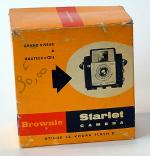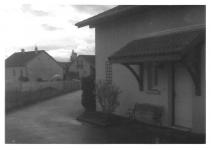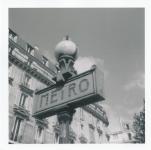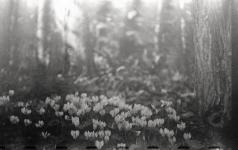|
Kodak Brownie Starlet (capot lisse) |
Manufactured or assembled in France from (Circa) 1960 to (Circa) 1966.
Index of rarity in France: Very usual (among non-specialized garage sales)
Inventory number: 298
See the complete technical specifications
Chronology of cameras Kodak
At the end of the Second World War, Kodak had two historic factories in France: one in Sevran, which had been dedicated to film development since the 1920s, and another in Vincennes, formerly known as Pathé and since 1927, Kodak-Pathé, where films were manufactured. There were no camera manufacturing units at that time, and all Kodak cameras available in France were imported products.
As part of the national industrial reconstruction effort, imports became much more difficult, and it became necessary to manufacture the cameras sold in France domestically. This is what Kodak did, based on four series of cameras: the 127 series with names starting with "Star," the Pony series, an entry-level 135 series, the Retinette series, a higher-quality 135 series, and folding cameras in the 620 format. For each of these series, Kodak used existing camera models from the USA or Great Britain as a basis. The question arises as to whether this involved true manufacturing or simply assembly with French-made lenses. The Brownie Flash can also be mentioned in this context.
The French Kodak cameras with names starting with "Star" all have a 4 x 4 cm format on 127 film. They are made of plastic, fixed-focus, with a simple eye-level viewfinder integrated into the camera. They have two apertures and a single shutter speed. Loading is done by opening the bottom, which allows access to the two spools and the chamber.
The front face is adorned with an aluminum plate, almost identical from one model to another. The Kodak logo sometimes changes sides, and the Brownie logo evolves. The shutter release lever is very small and red in color. It's possible that some plastic components are common to several models; for example, the Starflash has a parabolic reflector for a bulb flash, but the two holes for flash attachment on the Starlet are clearly visible.
These models are derived from their American counterparts, but across the Atlantic, some "Star" models never had French equivalents.
| Model | Flash | Years | ||
| Starflash |  |
PF1 bulb flash parabolic reflector. The 22.5V battery for the flash is located behind the reflector. | Kodak logo on the left or right. |
1960-62 |
| Startech |  |
Derived from the Starflash, designed for macrophotography. The aperture settings are replaced by those for the focusing distance. | Sold with the essentials for close-up photography. |
c. 1963 |
| Starlet |  |
Side connection for a bulb flash. | Kodak logo on the left or right. Aperture indicated by "Color/ Black & White" or "Hazy Sun / Bright Sun." The plate on the top can be smooth or textured. |
1960-66 |
| Starluxe |  |
Small round reflector for PF1 bulb. In the compartment for the 22.5-volt battery, there is an adapter for AG1 bulb. | 1961-65 | |
| Starluxe II |  |
Small rectangular reflector for a bulb. The technical specifications remain unchanged. | Available in white or two-tone. | 1964-67 |
Traduction de Sylvain Halgand
Attention, this model should not be confused with Starlet the U.K. which is completely different.
For the general information concerning the French family of Brownie Star, please refer to the page of Starflash.
The shutter has one alone speed and the lens is a meniscus with Focusing fixed of 1,20 m ad infinitum.
Contrary to the other members of the family of Brownie 127 Starsomething, Starlet does not have a built-in flash. It on the other hand is provided with two pins making it possible to fix on side small flash Kodak (Flash C or D).
I noted that this camera very running in the second hand markets, a few years ago, is a little less now. Less, it remains one of the angular stones of the collection of the beginner, would be this only by its price, generally lower than 10 euros .
No one does not announce the existence of two different versions:
- the first with cap higher made of aluminum, rhombus and striated. The Kodak logo is on the right (by looking at the camera). The legend of the apertures is: 13 buckled Sun and Soleil shining 14
- the second with cap higher made of aluminum, rhombus and smooth. The Kodak logo is on the left. The legend of the apertures is: 13 color and Noir & white 14.
Mr. Dithurbide (see the Bencini pages) indicates a new difference to me between the two variants of Kodak Brownie Starlet. This difference relates to the plate visible with the bottom of the lens. This plate slides to let pass the light when one appuye on the shutter release.
The model 13 color/14 black and white with thus a logo “simplified” Kodak on the left has a smooth plate whereas the model 13 sun buckled/14 sun shining with its “more traditional” Kodak logo on the right, has as for him a sliding plate whose surface is strewn with small regular holes. This type of coating evokes that of the sliding plate visible with the bottom of the lens of Brownie Flash (French version of Hawkeye).
In 1966 (Natkin catalogs), the starlet was worth 29,50 francs and the flash 19,30 francs . It was also available in outifit to 64,50 francs .

Interesting links or bibliography :
| Sur mes-appareils-photos.fr, suggested by Eric Carlhan |
 |
Add a link or element of bibliography, a picture taken with this camera, a picture of box or an ads about this camera
Your photos taken with the same camera:

| 
|
Cameras from Ebay France (Kodak) (Uploaded each 3 hours)



























